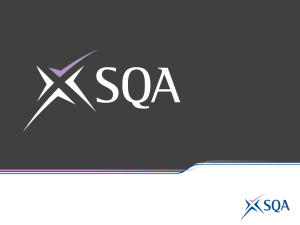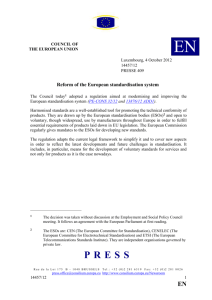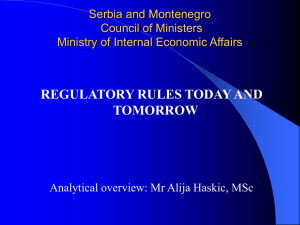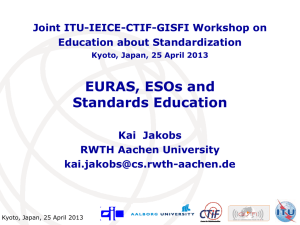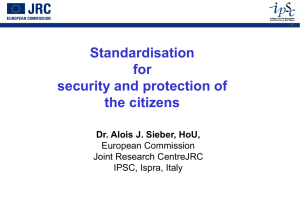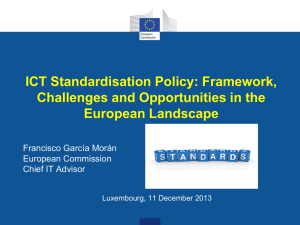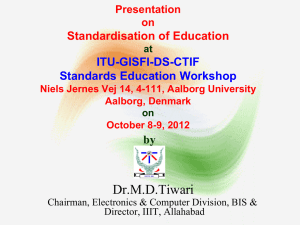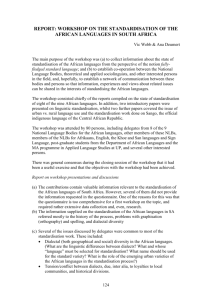(Future) Role of China in ICT Standardisation
advertisement
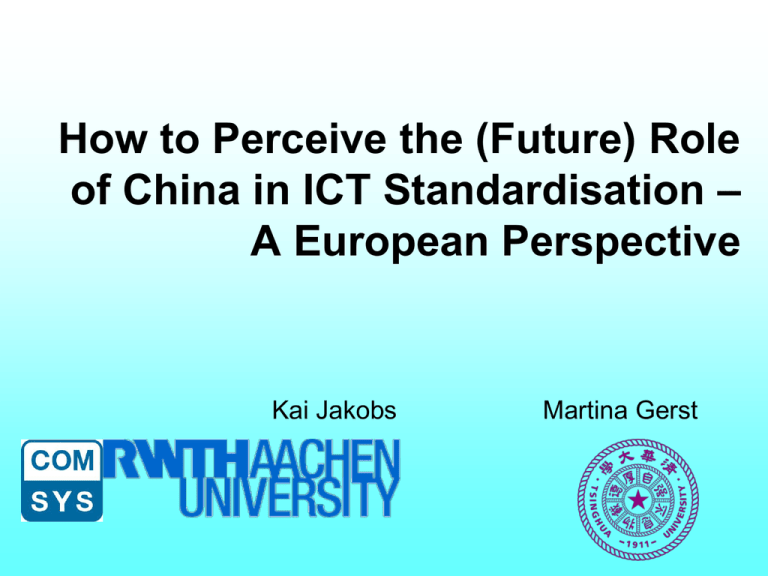
How to Perceive the (Future) Role of China in ICT Standardisation – A European Perspective Kai Jakobs Martina Gerst Why Look at China? • “Third tier companies make products; second tier companies make technology; first tier companies make standards”. – China is keen on ‘indigenous’ innovations. – And has realised the importance of standards to support this. – It has also recognised the importance of standards education. • China has emerged as a strong new player in international standardisation. • Plus, it’s got a huge internal market. The European Standardisation System The Chinese Standardisation System AQSIQ SAC MIIT CESI TCs CCSA WGs AQSIQ: General Administration of Quality Supervision, Inspection and Quarantine MIIT: Ministry of Industry and Information Technology SAC: Standardization Administrative of China CESI: China Electronics Standardization Institute CCSA: China Communications Standards Association Deliverables In the EU • (European/Harmonised) Standards • Technical Specifications (TS), • Technical Reports (TR), • Workshop Agreements / Industry Specifications In China, they’ve got standards • ‘National’ (15% mandatory; 85% voluntary) • ‘Professional’ • ‘Local’ • ‘Enterprise’. Standardisation Development Ladder 8. Enter proposals at WTSA on future study questions and work programmes. 7. Nominate representatives as SG chairs, vice‐chairs, rapporteurs, etc. 6. Give contributions at SG meetings. 5. Attract ITU meetings. 4. Go to SG and related meetings. 3. ITU Sector and Associate Membership. 2. National training and capacity‐building in use of ITU Recommendations. 1. Growing use of ITU Recommendations. CSS – Strengths Good alignment with national policy making. Serious amounts of money may be made available for ‘lighthouse developments’. An over-arching standardisation strategy to guide future development of the system. Improved links between R&D and standardisation. Recognition of the importance of standards education. Clear vision of ‘internationalisation’ of domestic standards. CSS – Weaknesses Supervision by government may limit flexibility. As may the non-existence of ‘new deliverables’. A rather complex system of different and possibly contradicting standards at various (geographic) levels. Limited involvement of industry. Inadequate co-ordination government – industry. Still limited experiences with international SSOs. Limited number of leading functions in many international SSOs. No integration of consortium standards. CSS – Opportunities A large internal market gives economic clout. R&D in support of standards setting should yield superior standards with better chances of international market adoption. Well-educated standards setters will strengthen China’s position internationally. Clear focus on internationalisation of good domestic standards will help open up new markets. CSS – Threats Government-driven system may result in standards that do not meet current industry needs. System may not be flexible enough to adequately address the needs of the fast-moving ICT sector. Standards not owned by SAC may lead to contradicting standards and market fragmentation. Low visibility in international standardisation will reduce chances of national standards to succeed internationally. Ignoring consortium standards may leave China stranded with irrelevant (inter)national formal standards. Some EU – China Links in Standardisation • DIN (Siemens?!) provided PRC with full set of German standards in 1979. • Seconded European Standardization Expert for China (since 2006) – enhance visibility of European standardisation; – contribute to integration of China into the WTO system; – help European industry to maintain and increase its competitiveness in the global marketplace. • ‘Europe-China Standardization Information Platform’ Provides information about applicable and upcoming standards with relevance for the export to China or Europe of certain product categories. EU Attitude I • In general, the ESS is based on co-regulation; industry and government co-operate closely. • Largely geared towards co-operation rather than competition. • This view also extends to China that is seen as an important future market, especially for SMEs. EU Attitude II The EU is quite settled in her ways. • Recent(?) modifications included – the foundation of ETSI in1988; – the foundation of the Information Society Standardization System (CEN/ISSS) in 1997 (now disbanded again). • The ‘Digital Agenda’ still clearly distinguishes between ‘standardisation’ and ‘innovation’. • Standards education has become a popular topic but very little has happened so far. • Any effects of the recent new Regulation remain to be seen. What Can Europe See in China? I • China still needs to traverse much of the learning curve in ICT standardisation the EU has already passed: – – – – – Gain more international experience and prominence; Somehow come to terms with standards consortia; Overcome geographical split (e.g. local standards); Include all stakeholders (primarily industry); Become more flexible (e.g. ‘new deliverables’; consortium standards). What Can Europe See in China? II • China may have a long-term competitive edge: – Well developed standardisation strategy; – Aims to improve links to R&D; – Head start in standards education What Can Europe See in China? III • The Chinese Standardisation System is not to be feared per se – it has its strengths and weaknesses just like every other national/regional system. – China: essentially driven by government; EU: essentially driven by co-operation; US: essentially driven by competition; – Regional diversity. – Centralisation China EU US – Sectoral split US China EU The EU Can Learn From China • That an ICT standardisation strategy is a good thing to have. • That standardisation and innovation should not be considered separately. • That funding standards education is a good investment in the future of Europe’s technical and economic relevance. • That sometimes you just have to put your money where your mouth is ............ Thank You Very Much for Your Attention Questions, Please .....
